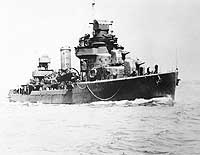
USS Gwin, a 1620-ton Gleaves class destroyer, was built at the Boston Navy Yard, Massachusetts. Commissioned in January 1941, she conducted Neutrality Patrols in the Caribbean until September, and thereafter participated in "short of war" operations out of Iceland. Gwin was transferred to the Pacific soon after the U.S. formally entered World War II in December 1941. In April 1942, she was part of the task force that carried the Army bombers that carried out the Doolittle raid on Japan. In early June, she was involved in the final stages of the Battle of Midway and was present when the crippled aircraft carrier Yorktown was sunk by a Japanese submarine.
In July 1942, Gwin steamed to the south Pacific, where she screened aircraft carriers during the invasion of Guadalcanal and Tulagi in early August. For the next four months, the destroyer participated in the campaign to hold Guadalcanal and on 15 November, during the second major surface action of the Naval Battle of Guadalcanal, engaged Japanese warships off Savo Island. Gwin was the only survivor of the four U.S. destroyers present, but damage from enemy shellfire sent her back to the U.S. for repairs and overhaul.
Gwin returned to the combat zone in April 1943, in time to join in the Allied advance up the Solomon Islands chain. She took part in the amphibious operation that captured Rendova Island, off New Georgia, in late June. Early the next month, she helped rescue survivors of the cruiser Helena, which had been sunk in the Battle of Kula Gulf. On 13 July, she was torpedoed amidships during the Battle of Kolombangara. After a losing struggle to save their critically damaged ship, her crew was taken off and USS Gwin was scuttled.
USS Gwin was named in honor of Lieutenant Commander William Gwin (1832-1863), who was mortally wounded while commanding USS Benton in action on the Yazoo River.
This page features the only views we have concerning USS Gwin (DD-433).
| If you want higher resolution reproductions than the digital images presented here, see: "How to Obtain Photographic Reproductions." |
Click on the small photograph to prompt a larger view of the same image.
In addition to the images presented above, the National Archives appears to hold at lease one other view of USS Gwin (DD-433). The following list features this image:
The image listed below is NOT in the
Naval History and Heritage Command's collections.
DO NOT try to obtain it using the procedures described in our
page "How to Obtain Photographic Reproductions".
|
USS Gwin (DD-415) off Rendova, Solomon Islands, during landings there on 30 June 1943. Taken by a photographer from the Third Amphibious Force View is taken from off the ship's port side, somewhat toward the bow and moderately distant (ship is about 30% of the image width). Reproductions of this image should be available through the National Archives photographic reproduction system for pictures not held by the Naval History and Heritage Command. The image listed in this box is NOT in the Naval History and Heritage Command's collections. DO NOT try to obtain it using the procedures described in our page "How to Obtain Photographic Reproductions". |
NOTES:
| If you want higher resolution reproductions than the digital images presented here, see: "How to Obtain Photographic Reproductions." |
Page made 6 March 2002
Coding updated 5 May 2009